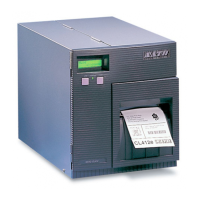Unit 7: Appendix
E/Pro Programming Reference
7-8 PN: 9001096E
CUSTOM PROTOCOL CODES
This chapter contains information on creating custom Protocol Command Codes. The Protocol Command Codes
tell the printer that a specific type of information is being transmitted to it. As an example, the Standard Protocol
Command Code specifies the use of an <ESC>character to tell the printer that the following character(s) will
represent a specific command. Sometimes the host computer is unable to generate the character or it uses the
<ESC> character to control another function. In this case, an Alternate Protocol Command Code set can be
selected for use. When the Alternate set is selected, the <ESC> character is not used and is instead replaced with
a “carrot” (^) character. A command stream would then start with an “^” instead of an “<ESC>”. These two sets of
Protocol Command Codes are adequate for the majority of all applications, but ocassionally situations occur where
conflicts exist when using the Alternate set. In these cases, the user can define and download a custom set of
Protocol Command Codes that are stored in non-voltile memory in the printer. After these are downloaded, they
replace the Alternate Command Code set.
The command for downloading a new set of Protocol Command Codes takes the form of
“<ESC>LD,a,b,c,d,e,f,g,h,i,j j”. The parameters specified for “a” through “i” can be transmitted in either ASCII
characters or hex notation, allowing a complete 128 character (except for the “,”) set to be used for selecting the
custom code.
PROTOCOL COMMAND CODES
PARAMETER STANDARD SETTING ALTERNATE SETTING
aSTX{
bETX}
c ESC ^
dENQ@
eCAN!
g OFFLINE ]
h (Auto Online) No 0=Yes, 1=No
i (Zero Slash) No 0=Yes, 1=No
j j (Eurocharacter) D5 User defined

